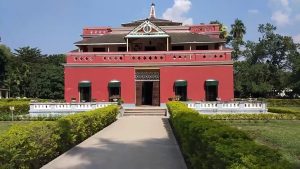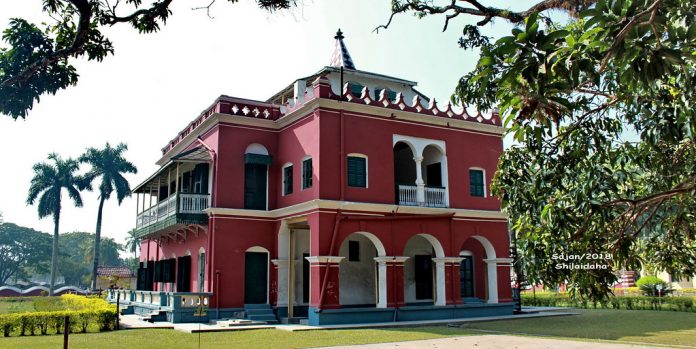Rabindranath’s house in Shilaidaha Kuthibari
— Topu Raihan
I live very close to home but I have never been able to visit the house with two eyes, this is my regret for a long time. It would be a great misfortune for an intense literary lover like me not to visit the place where the world poet himself has been in the dust for more than three decades.
Why did Rabindranath himself say, many crores away for many days … a dew drop on a grain of rice! My condition was the same. I have set foot in many places, I have not only gone to Rabindra Bhavan. Unfortunately, this time it came to an end. The distance from Jhenaidah to Kushtia is fifty kilometers. And from Kushtia to Kuthibari it will be about twelve kilometers.
Literary love-Rabindra fascination has really come true this time by spending the accumulated enthusiasm accumulated for a long time. The soil of Bengal, the water of Bengal was so dear to the world poet that it was a proper realization in an afternoon at the house. Fakhrul Azam Russell and Hasan Hafizur Rahman, two traveling friends, set out for Kuthibari with dollars.
As soon as he reached Kushtia, he felt the pull of Shilaidaha. That pull dragged me to the house along the winding road that melted the endless green gap. The main road from Kushtia Chowdhury ends at Alauddin Nagar. From then on, we traveled along the narrow paved road through the middle of Alauddin Nagar to the house of the poet through the snake-like winding road.
The fascination that was the purpose of this journey was further enhanced by the fact that only green paddy fields, trees, and the busyness of arranging people’s families could be seen around the journey. Really, if the journey to the east of the destination is not pleasant and eye-catching, then the pull towards the main place of interest is a little dirty! The tension in the scenic view of the destination increased my tension even more.
I rented a van for ten rupees each and reached Kuthibari. The height of the house is two and a half stories. The house is the main attraction of the place. If we want to say the real beauty of the house built in a wonderful style of construction, we have to write it in the language of poetry like the world poet.  Why, Rabindranath Tagore made a wonderful statement about the pyramids of Egypt, here the language of stone has surpassed the language of man… I think this remarkable quote of the poet himself can be easily passed on to his family. But in place of the stone of the pyramid, bricks have to be placed here.
Why, Rabindranath Tagore made a wonderful statement about the pyramids of Egypt, here the language of stone has surpassed the language of man… I think this remarkable quote of the poet himself can be easily passed on to his family. But in place of the stone of the pyramid, bricks have to be placed here.
 Why, Rabindranath Tagore made a wonderful statement about the pyramids of Egypt, here the language of stone has surpassed the language of man… I think this remarkable quote of the poet himself can be easily passed on to his family. But in place of the stone of the pyramid, bricks have to be placed here.
Why, Rabindranath Tagore made a wonderful statement about the pyramids of Egypt, here the language of stone has surpassed the language of man… I think this remarkable quote of the poet himself can be easily passed on to his family. But in place of the stone of the pyramid, bricks have to be placed here.The infinity fascination was gained by looking around the house. I was repeatedly thrilled to think, is this the house! The house that we are walking through this desert is exactly where the world poet used to walk a hundred years ago? He had paper and ink in his hand, pen. In the background, he used to talk to the river Padma flowing in Sagaurbe-Sollas and used to enchant the sky and air of Bengal by writing songs and poems.
I also had the good fortune to visualize Rabindranath Tagore several times. It was normal, looking at the intact windows of the house, through the open window, I could see the poet’s delight in nature view of Bengal. The poet probably loved plants very much. And why not love? If the mind is not green like nature, then one cannot become a world poet. 

That is why the shade of some Rabindranath trees was found in the west-east-north corner around the house. The large old jackfruit tree at the back of the house still has many of its twigs, which is a testament to Rabindranath’s return to the house.
If human vowels were found, perhaps many unknown things could be known about the poet from them. Four palm trees standing side by side on the east side. The three are together, a palm tree a little farther apart. My favorite rhyme was probably written by the poet Tagore in his time by looking at one of these trees.
The Tagore family established this house on 30 bighas of land. The architectural style of this three-story house is very much like a pagoda. There is a boundary wall around the two bighas of land, which is eye-catching and beautiful, facing south. His grandfather Prince Dwarkanath Tagore became the owner of the zamindari at Patisar and Shahjadpur in the greater Rajshahi district of Bangladesh in 1830.
The center of this zamindari was Shilaidaha. The poet’s brothers Dwijendranath, Jyotirindranath, Satyendranath, and others have come to Shilaidaha to see a natural beauty and captivating form of Kushtia for the purpose of supervising the zamindari work. The poet first came to Shilaidaha in 18, and later in 1892 took charge of the zamindari. Rabindranath lived in a house in Shilaidaha for a long time.
But the poet liked the natural beauty of Shilaidaha so much that he was fascinated and expressed his desire to live permanently. The poet had a strong attraction towards the river Padma. In this Shilaidaha, almost all the Tagore dynasty lived in rural buildings and enjoyed the beauty of the Padma, Gorai Bidhaut rural nature. From 1892 to 1922, Rabindranath Tagore was in and out of Shilaidaha.
Shilaidaha Rabindranath Tagore’s mansion has been preserved as a glorious memory since 1958 under the management of the Archaeological Department. After the independence of Bangladesh in 1971, realizing the importance of Kuthibari, it was established as a museum by collecting various works of art of the poet. Rabindra Lilaniketan is full of different species of trees.
The same impression is made on the cornice of the roof of the cottage, which is protected by a wall resembling the waves of the Padma on the 2 bighas of land of the main building in Chilakotha architecture. There are 6 rooms on the first and second floors and 16 rooms on the third floor. The poet’s writing room was on the third floor. The poet has written many poems and stories sitting in this room.



